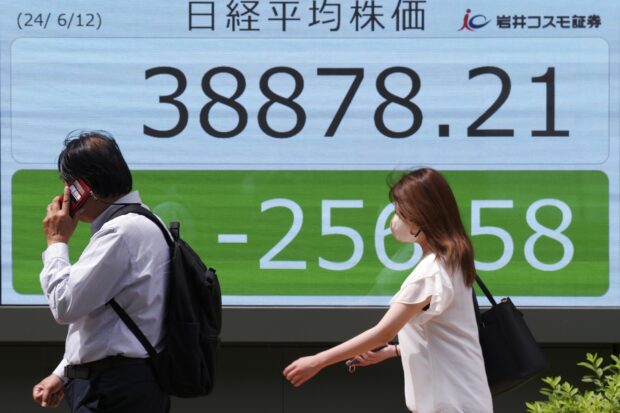
People walk in front of an electronic stock board showing Japan’s Nikkei 225 index at a securities firm Wednesday, June 12, 2024, in Tokyo. (AP Photo/Eugene Hoshiko)
Tokyo, Japan — The yen slid to its weakest value against the dollar since 1986 on Friday, putting investors on alert for a possible fresh forex intervention by the Japanese government.
One dollar bought 161.12 yen at around 0100 GMT, compared with 160.70 yen in early Tokyo trade.
It came as Japanese shares opened higher, taking cues from Wall Street rallies as traders awaited key US inflation data.
READ: Yen gains after hitting 38-year low, traders on intervention watch
The benchmark Nikkei 225 index was up 0.90 percent, or 355.76 points, at 39,697.30, while the broader Topix index rose 0.90 percent, or 25.23 points, to 2,818.93.
Japan’s finance ministry spent 9.79 trillion yen ($61 billion) to prop up the yen between April 26 and May 29.
But analysts now say it is possible traders will keep pushing the envelope to see at what point the government will act, with some saying the currency could hit 170.
The Japanese currency has cratered from around 115 per dollar before Russia’s February 2022 invasion of Ukraine.
This plunge is due in part to the Bank of Japan’s policy of maintaining ultra-low interest rates to support the economy, while other central banks have hiked theirs.
Among major shares in Tokyo, SoftBank Group added 1.97 percent to 10,335 yen, Sony Group climbed 2.14 percent to 13,820 yen and Toyota gained 0.73 percent to 3,287 yen.
US investors are looking ahead to PCE price data, which is expected to influence upcoming interest rate decisions.
“The Japanese market was seen starting higher following gains on Wall Street,” Monex senior analyst Toshiyuki Kanayama said.
“The focus will be whether Nikkei will be able to widen its gains after a round of buying in the morning”.
Shortly before the opening bell, ministry data showed Japan’s industrial output for May increased 2.8 percent from the previous month.

